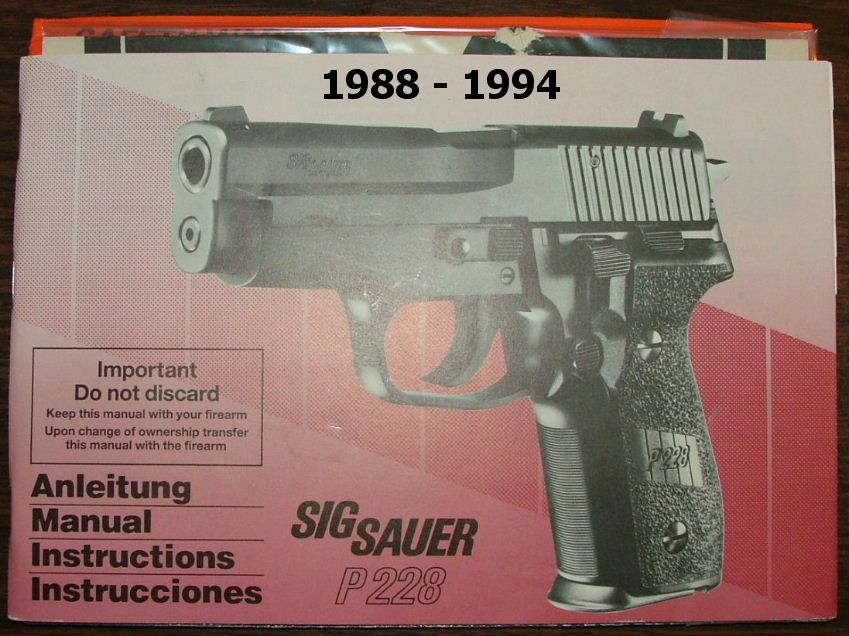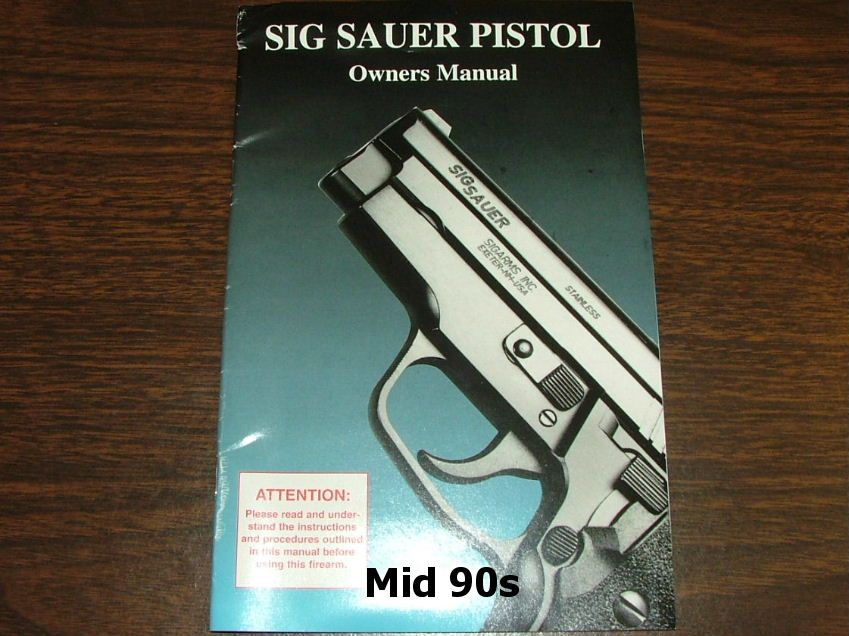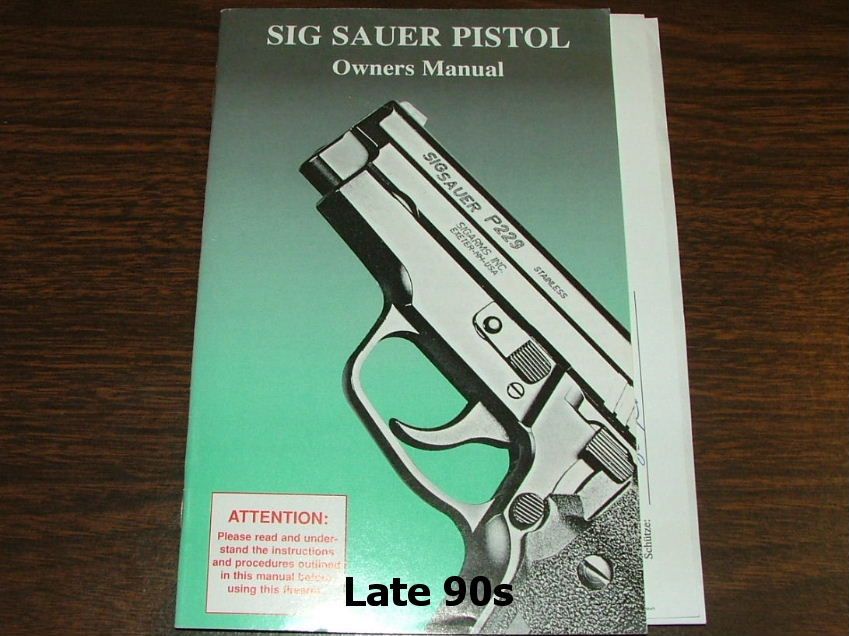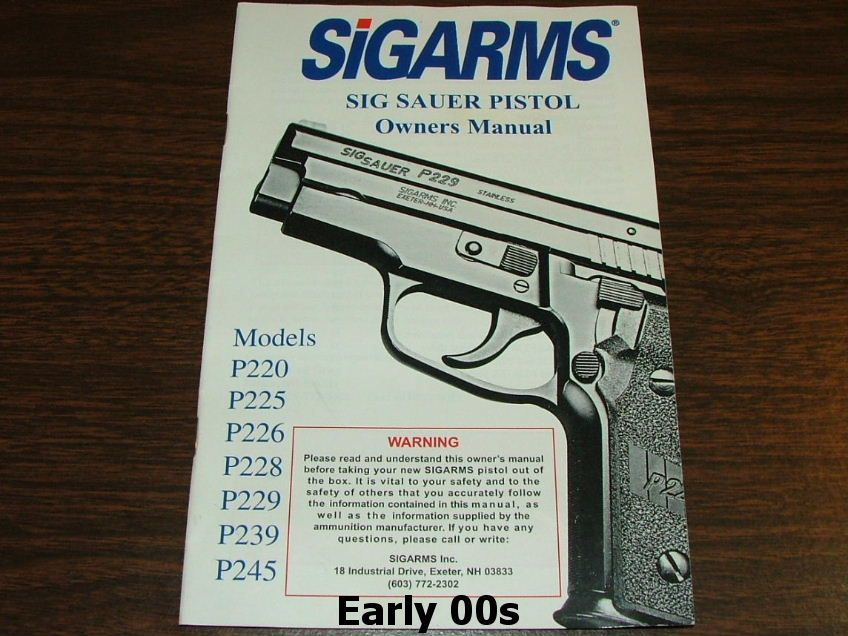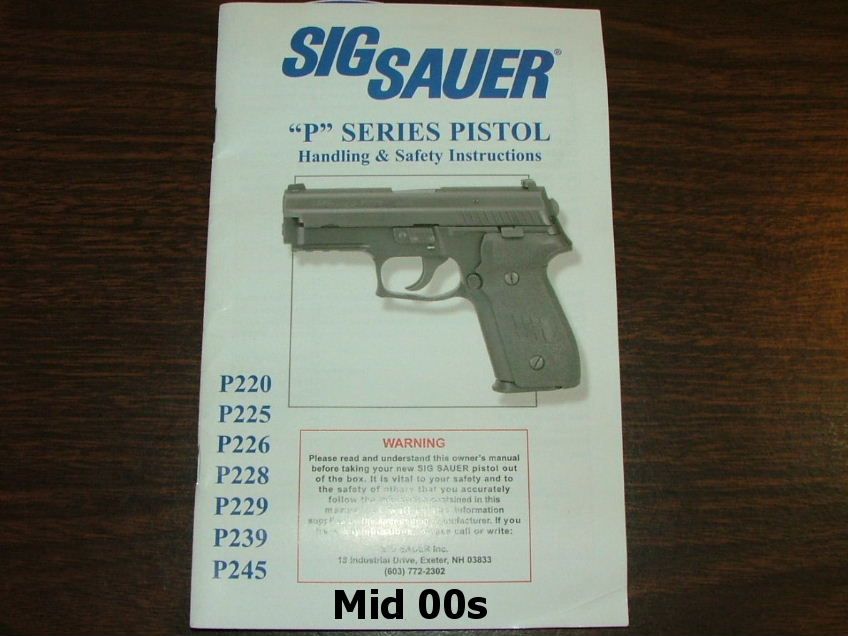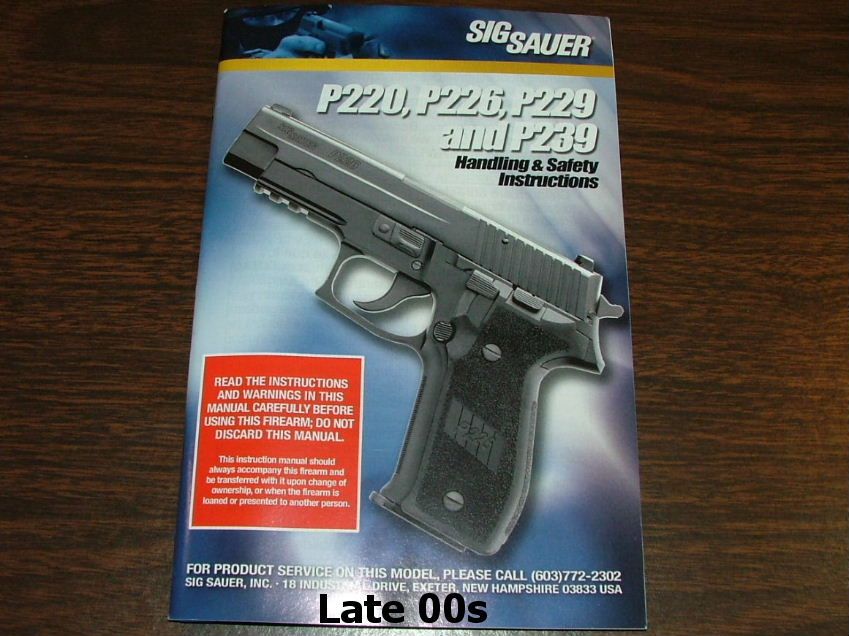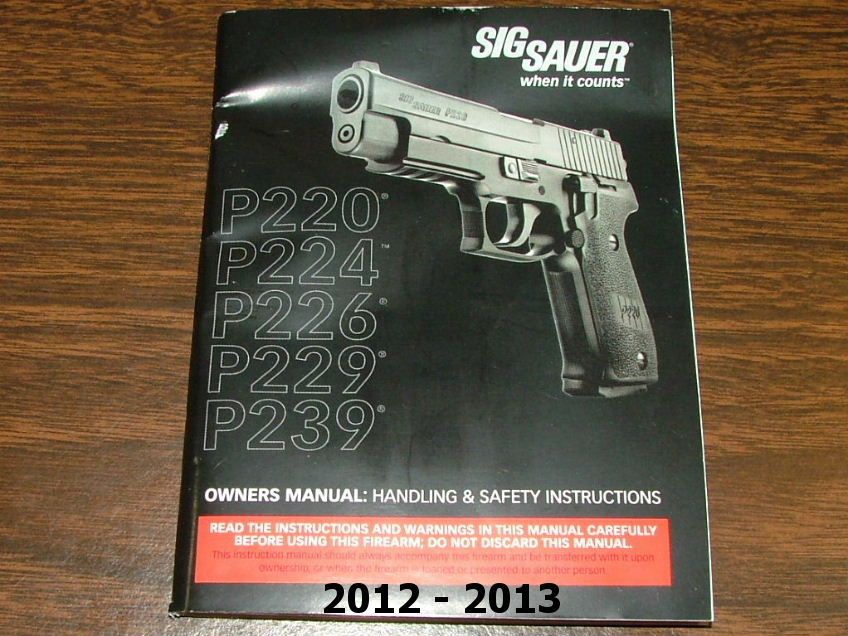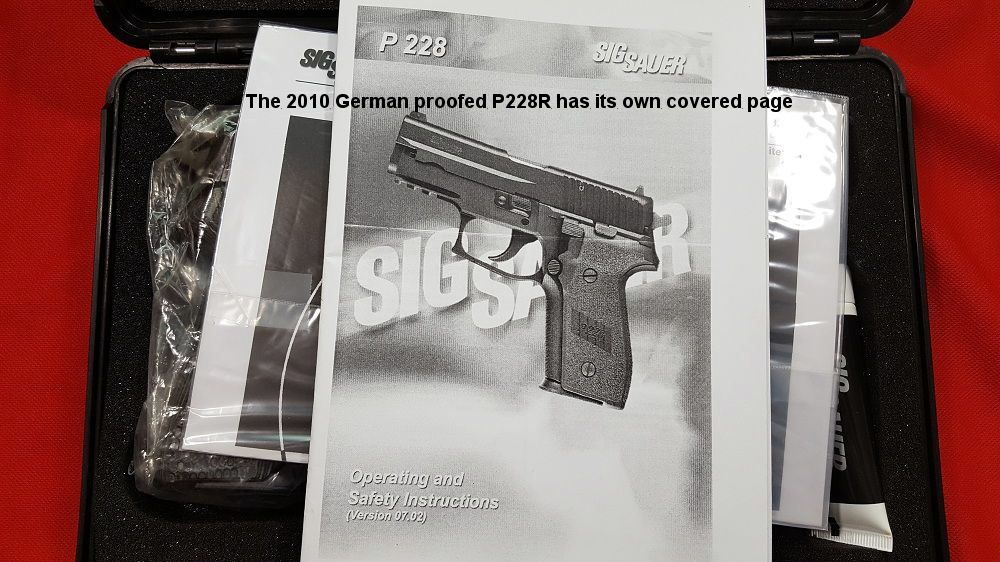P228 Factoids & Opinions/Comments
This is the work of just an amateur who loves the P228 and who is by no means expert, guru, or whatever. Information contained in here are gathered from personal experience, by studying online sources and by learning from many individuals (some are/were employees of SIG DE and SIG USA).
Please note that my info focus mainly on models for the US commercial market, not Euro versions.
You'll notice that there aren't any info on specs, as these can be easily found anywhere on the internet. My focus is to put a lot of trivial info that cannot be easily found into one convenient place for the P228 fan to look up. You’ll also notice that I make no claim about which era P228s are “better” (W. German made/proofed vs. German made/proofed vs. German made/US assembled).
I invite anyone who has additional info and pics, interesting tidbits, or who spots incorrect info by me, to chime in and contribute. Thank you in advance.
And, thank you to the staff on ST for giving me the space to do this.
-----------------------------------------------------------------------------------------
Contents
Post #1 - General factoids
Post #2 - Special / Limited models
Post #3 - DAK compatible models
Posts #4-#6 - Gun pics
Posts #7-#8 - P226 Compact prototype
-----------------------------------------------------------------------------------------
Definition of the P228:
A. Production years: 1988 – 2005
Note: 1988 was the 1st year for the P228, serial numbers B100001 - B100100. However, these JJ date code P228s were never intended for public sale.
Guns serial numbered B100001 to B100059, plus B100069 to B100099, were sent to SIG HQ in Switzerland.
B100060 to B100068, plus B100100, were sent to SIG Arms in Herndon VA, USA.
B. Intermittent release years: 2007, 2009, 2010-11, 2012-13
C. Serial numbers: BXXXXXX (1988 – 2013); AAU (2009); AJU-, AHU-, AKU-XXXXX (2012 – 2013).
Note: There have been speculations of the existence of factory original P228s with early P229 style serial numbers. Although a possibility, it remains unconfirmed.
D. Made and proofed in W. Germany: 1988 – 1995 (proof marked and date coded, with triple matching serial #s on frame, slide, and barrel)
E. Made and proofed in Germany: 1995 – 1999 (proof marked and date coded, with triple matching serial #s on frame, slide, and barrel). Note that year 1995 is the transition year that has both W. German made and German made P228s.
F. Made in Germany/Assembled in US: 2000 – 2013 (serial # on frame only; no German proof marks*). Note that some frames are German made, and some are US made.
“*” denotes certain exceptions as follows:
1. 2011 sold P228Rs are German made and proofed (in 2010, BA date code).
2. Some 2011 & 2012 M11Bs are German made and proofed (with BB and BC date codes).
3. The 2012 & 2013 stainless frame P228s are all German made and proofed (BC and BD date codes).
G. All nickel models: There are no factory P228s that were nickel plated in W. Germany, since SIG Germany stopped doing their own plating with the last known nickel P226 in 1987, and the P228 didn’t start life until 1988. Klein Plating of Erie, PA did most, if not all, of the nickel plating for SIG in the 90s. The earliest known is 1990 (KA); latest known is 1997 (KH).
H. Two-tone nickels: Earliest known is 1991 (KB). The latest known is 2005 (Nov ’05 GOTM), and it’s unclear who did the plating for this one, since Klein stopped the firearm business by the end of the 20th century. All black controls: 1991 to 1994. All nickel controls: 1994 to 2005.
All the Klein plated SIGs were Electroless Nickel (EN).
The following is the post by the President of Klein several years ago on here, post #21 in this thread, p228 nickel question., and I quote:
NOTE: This is verbatim from Mr. Dudenhoeffer > "On a two-tone Sig we typically would not have plated the breech block and barrel. These were left untouched. The only time we would have done this is for an individual request and is not something that would have come directly from Sig. Only the slide would have been plated and polished along with various external components such as the trigger, hammer, de-cocking lever, magazines, etc. On a full nickel gun all external components were plated and the breech block and barrel would also have been left alone."
I. Comments regarding nickel or 2-tone nickel guns: You may agree or disagree, but in my humble opinion, the only way to know if you have a factory original gun is one of the following, and this is especially important for any buyer about to fork out a bunch of cash to get a supposedly factory original nickel gun.
1. You are the original owner/purchaser of such a gun (with everything that came with it).
2. The gun has the original box with the outer label having “NICKEL” or “NICKEL T” or "T" on it.
3. SIG confirms for you in writing that your gun is original. If it's not in writing, it didn't happen. “SIG CS told me on the phone” is meaningless.
Following is the list of confirmed factory Nickel and Two-tone Nickel P228s. If you have one or more and would like to add to it, please post and let me know. Thanks.
-B116-623-KA-1990-Factory Ni (per 12131)
-B118-768-KA-1990-Factory Ni (per 12131)
-B135-113-KB-1991-Factory TTNi (per 12131)
-B135-467-KB-1991-Factory TTNi (per 12131)
-B137-326-KB-1991-Factory TTNi (per 12131)
-B138-757-KB-1991-Factory TTNi (per 12131)
-B140-994-KB-1991-Factory TTNi / Slide & barrel subsequently refinished in CPII (per 12131)
-B151-593-KB-1991-Factory Ni (per 12131)
-B151-653-KB-1991-Factory Ni (from GB)
-B151-694-KB-1991-Factory Ni (from bolo4tom)
-B151-700-KB-1991-Factory Ni (from Shack)
-B152-161-KB-1991-Factory Ni (from GB)
-B152-183-KB-1991-Factory Ni (per 12131)
-B152-191-KB-1991-Factory Ni (per 12131)
-B152-251-KB-1991-Factory Ni (per 12131)
-B152-549-KB-1991-Factory Ni (from GB)
-B152-562-KB-1991-Factory Ni, but was aftermarket bright polished (from GB)
-B152-610-KB-1991-Factory Ni (per 12131)
-B165-446-KC-1992-Factory Ni (per 12131)
-B202-9xx-KD-1993-Factory Ni (from sphillips)
-B203-017-KD-1993-Factory Ni (per 12131)
-B204-245-KE-1994-Factory Ni (from GB)
-B219-458-KE-1994-Factory TTNi (per 12131)
-B231-030-KF-1995-TTNi (from GB)
-B237-959-KF-1995-Factory TTNi (per 12131)
-B240-835-KF-1995-Factory TTNi (per 12131)
-B241-729-KF-1995-Factory Ni (per 12131)
-B241-899-KF-1995-Factory TTNi (per 12131)
-B246-523-KF-1995-Factory Ni (from GB)
-B246-766-KF-1995-Factory Ni (from GB)
-B259-108-KG-1996-Factory Ni (per 12131)
-B277-907-KH-1997-Factory TTNi (per 12131)
-B279-164-KH-1997-Factory Ni (per 12131)
-B306-999-no date code; factory 2-tone; factory blue box-E28-9-TSS-G (from schwankster)
-B334-672-no date code-2005-US assembled. Factory TTNi Nov 2005 GOTM (per 12131)
J. Trigger (serrated face vs. smooth face): The serrated trigger was on the P228 from the beginning > The transition year to smooth face trigger was 1994.
K. Grips: Early stock grips are without the lanyard loop at the bottom. Starting in 1992, grips have the lanyard loop.
L. Boxes/Cases:
* 1988 – 1989: red cardboard
* 1990 – 1994: gray cardboard (Note: the earliest 1990 (KA) P228 comes in the red cardboard box, before the move from Herndon, VA to Exeter, NH)
* 1994 – 1998: gray plastic (with soft outer cardboard sleeve)
* 1998 – 2000: large black plastic
* 2001 – 2009: large blue plastic
* 2010 – 2013: small black plastic
In the pic below, note that the small black box on the top right corner belongs to the stainless frame P228.
Not shown below, but a Certified Pre-Owned (CPO) box can be anything/any colors, although most of the time, it is a red plastic case. However, not all CPO SIGs come in the red box. How can you tell if it's a CPO gun? By looking for the red CPO grip band, if it's till there, or by looking at the box label, if it's still there. The label for the Item Number of a CPO SIG will always start with UD. Sometimes sellers will tell you the gun is factory new and original, but the "UD" on the label will tell you the story. LE returned guns will always be re-sold by SIG as CPOs. Even those that sat in the LE agency armory for years and were never used cannot be re-sold by SIG as new guns. They will be CPO’ed.
![Image]()
Special note on the gray plastic case (#3): Complete package should include the soft outer cardboard sleeve with the factory labels. If you're missing the sleeve, you can still determine if the plastic case is original to the gun by prying out the right side of the foam insert inside the case. There should be a factory label there with the gun's info (as shown below).
![Image]()
M. Magazines:
i - Early mags (pre-ban) are German made (JK through pre-ban KE):
1. None of them has any "Made In Germany" or "Made in W. Germany" on them.
2. The JK and KA have the following markings on the left side: "SIG SAUER", "P228".
3. The KB through KE have only "SIG SAUER" on the mag's left side, but no "P228".
4. The SIG "triskelion" started its regular appearance on the KB and subsequent years, although it did make spotty appearance on the JK & KA.
5. The date clock on the floor plate did not make its appearance until mid 1994. Just my guess, but that makes sense, as gun makers were staring down the AWB's barrel at the time. Before that, they did not have to worry about it.
6. Zipper back: JK, KA, KB.
7. Dove tails: KC and onward.
ii - Ban era mags have "Made In Germany" rollmarked on right side of body, "SIG SAUER 9mm" on left side of body, have dove tailed back, but no triskelion, since the bottom part was chopped off to make room for the capacity limiting plastic block.
![Image]()
![Image]()
![Image]()
![Image]()
![Image]()
N. Manuals:
In its early years, the P228, like its older brothers (P220, P225, P226), had its own Manual, with red cover. In the subsequent years, the Manual is just generic for all of the "P" models. The 2010 German proofed P228R, however, has the manual specific for it with its own cover page.
![Image]()
![Image]()
![Image]()
![Image]()
![Image]()
![Image]()
![Image]()
![Image]()
This is the work of just an amateur who loves the P228 and who is by no means expert, guru, or whatever. Information contained in here are gathered from personal experience, by studying online sources and by learning from many individuals (some are/were employees of SIG DE and SIG USA).
Please note that my info focus mainly on models for the US commercial market, not Euro versions.
You'll notice that there aren't any info on specs, as these can be easily found anywhere on the internet. My focus is to put a lot of trivial info that cannot be easily found into one convenient place for the P228 fan to look up. You’ll also notice that I make no claim about which era P228s are “better” (W. German made/proofed vs. German made/proofed vs. German made/US assembled).
I invite anyone who has additional info and pics, interesting tidbits, or who spots incorrect info by me, to chime in and contribute. Thank you in advance.
And, thank you to the staff on ST for giving me the space to do this.
-----------------------------------------------------------------------------------------
Contents
Post #1 - General factoids
Post #2 - Special / Limited models
Post #3 - DAK compatible models
Posts #4-#6 - Gun pics
Posts #7-#8 - P226 Compact prototype
-----------------------------------------------------------------------------------------
Definition of the P228:
- Slide is folded/stamped carbon steel with a pinned breech block, with one exception (see below, about the NJSP stainless slide P228).
- Frame is anodized aluminum alloy, with one exception (see below, about the Afton Arms stainless frame P228).
- An all stainless factory made P228 does NOT exist.
- A .40/.357 caliber factory folded slide P228 does not exist, although there was a recent unverified claim that it does.
A. Production years: 1988 – 2005
Note: 1988 was the 1st year for the P228, serial numbers B100001 - B100100. However, these JJ date code P228s were never intended for public sale.
Guns serial numbered B100001 to B100059, plus B100069 to B100099, were sent to SIG HQ in Switzerland.
B100060 to B100068, plus B100100, were sent to SIG Arms in Herndon VA, USA.
B. Intermittent release years: 2007, 2009, 2010-11, 2012-13
C. Serial numbers: BXXXXXX (1988 – 2013); AAU (2009); AJU-, AHU-, AKU-XXXXX (2012 – 2013).
Note: There have been speculations of the existence of factory original P228s with early P229 style serial numbers. Although a possibility, it remains unconfirmed.
D. Made and proofed in W. Germany: 1988 – 1995 (proof marked and date coded, with triple matching serial #s on frame, slide, and barrel)
E. Made and proofed in Germany: 1995 – 1999 (proof marked and date coded, with triple matching serial #s on frame, slide, and barrel). Note that year 1995 is the transition year that has both W. German made and German made P228s.
F. Made in Germany/Assembled in US: 2000 – 2013 (serial # on frame only; no German proof marks*). Note that some frames are German made, and some are US made.
“*” denotes certain exceptions as follows:
1. 2011 sold P228Rs are German made and proofed (in 2010, BA date code).
2. Some 2011 & 2012 M11Bs are German made and proofed (with BB and BC date codes).
3. The 2012 & 2013 stainless frame P228s are all German made and proofed (BC and BD date codes).
G. All nickel models: There are no factory P228s that were nickel plated in W. Germany, since SIG Germany stopped doing their own plating with the last known nickel P226 in 1987, and the P228 didn’t start life until 1988. Klein Plating of Erie, PA did most, if not all, of the nickel plating for SIG in the 90s. The earliest known is 1990 (KA); latest known is 1997 (KH).
H. Two-tone nickels: Earliest known is 1991 (KB). The latest known is 2005 (Nov ’05 GOTM), and it’s unclear who did the plating for this one, since Klein stopped the firearm business by the end of the 20th century. All black controls: 1991 to 1994. All nickel controls: 1994 to 2005.
All the Klein plated SIGs were Electroless Nickel (EN).
The following is the post by the President of Klein several years ago on here, post #21 in this thread, p228 nickel question., and I quote:
NOTE: Nickel P228s all came from Germany first as blued guns. When SIG NH sent some to Klein to be Nickel plated, part of the prep work required the frame anodization to be stripped before plating can be done.
NOTE: This is verbatim from Mr. Dudenhoeffer > "On a two-tone Sig we typically would not have plated the breech block and barrel. These were left untouched. The only time we would have done this is for an individual request and is not something that would have come directly from Sig. Only the slide would have been plated and polished along with various external components such as the trigger, hammer, de-cocking lever, magazines, etc. On a full nickel gun all external components were plated and the breech block and barrel would also have been left alone."
I. Comments regarding nickel or 2-tone nickel guns: You may agree or disagree, but in my humble opinion, the only way to know if you have a factory original gun is one of the following, and this is especially important for any buyer about to fork out a bunch of cash to get a supposedly factory original nickel gun.
1. You are the original owner/purchaser of such a gun (with everything that came with it).
2. The gun has the original box with the outer label having “NICKEL” or “NICKEL T” or "T" on it.
3. SIG confirms for you in writing that your gun is original. If it's not in writing, it didn't happen. “SIG CS told me on the phone” is meaningless.
Following is the list of confirmed factory Nickel and Two-tone Nickel P228s. If you have one or more and would like to add to it, please post and let me know. Thanks.
-B116-623-KA-1990-Factory Ni (per 12131)
-B118-768-KA-1990-Factory Ni (per 12131)
-B135-113-KB-1991-Factory TTNi (per 12131)
-B135-467-KB-1991-Factory TTNi (per 12131)
-B137-326-KB-1991-Factory TTNi (per 12131)
-B138-757-KB-1991-Factory TTNi (per 12131)
-B140-994-KB-1991-Factory TTNi / Slide & barrel subsequently refinished in CPII (per 12131)
-B151-593-KB-1991-Factory Ni (per 12131)
-B151-653-KB-1991-Factory Ni (from GB)
-B151-694-KB-1991-Factory Ni (from bolo4tom)
-B151-700-KB-1991-Factory Ni (from Shack)
-B152-161-KB-1991-Factory Ni (from GB)
-B152-183-KB-1991-Factory Ni (per 12131)
-B152-191-KB-1991-Factory Ni (per 12131)
-B152-251-KB-1991-Factory Ni (per 12131)
-B152-549-KB-1991-Factory Ni (from GB)
-B152-562-KB-1991-Factory Ni, but was aftermarket bright polished (from GB)
-B152-610-KB-1991-Factory Ni (per 12131)
-B165-446-KC-1992-Factory Ni (per 12131)
-B202-9xx-KD-1993-Factory Ni (from sphillips)
-B203-017-KD-1993-Factory Ni (per 12131)
-B204-245-KE-1994-Factory Ni (from GB)
-B219-458-KE-1994-Factory TTNi (per 12131)
-B231-030-KF-1995-TTNi (from GB)
-B237-959-KF-1995-Factory TTNi (per 12131)
-B240-835-KF-1995-Factory TTNi (per 12131)
-B241-729-KF-1995-Factory Ni (per 12131)
-B241-899-KF-1995-Factory TTNi (per 12131)
-B246-523-KF-1995-Factory Ni (from GB)
-B246-766-KF-1995-Factory Ni (from GB)
-B259-108-KG-1996-Factory Ni (per 12131)
-B277-907-KH-1997-Factory TTNi (per 12131)
-B279-164-KH-1997-Factory Ni (per 12131)
-B306-999-no date code; factory 2-tone; factory blue box-E28-9-TSS-G (from schwankster)
-B334-672-no date code-2005-US assembled. Factory TTNi Nov 2005 GOTM (per 12131)
J. Trigger (serrated face vs. smooth face): The serrated trigger was on the P228 from the beginning > The transition year to smooth face trigger was 1994.
K. Grips: Early stock grips are without the lanyard loop at the bottom. Starting in 1992, grips have the lanyard loop.
L. Boxes/Cases:
* 1988 – 1989: red cardboard
* 1990 – 1994: gray cardboard (Note: the earliest 1990 (KA) P228 comes in the red cardboard box, before the move from Herndon, VA to Exeter, NH)
* 1994 – 1998: gray plastic (with soft outer cardboard sleeve)
* 1998 – 2000: large black plastic
* 2001 – 2009: large blue plastic
* 2010 – 2013: small black plastic
In the pic below, note that the small black box on the top right corner belongs to the stainless frame P228.
Not shown below, but a Certified Pre-Owned (CPO) box can be anything/any colors, although most of the time, it is a red plastic case. However, not all CPO SIGs come in the red box. How can you tell if it's a CPO gun? By looking for the red CPO grip band, if it's till there, or by looking at the box label, if it's still there. The label for the Item Number of a CPO SIG will always start with UD. Sometimes sellers will tell you the gun is factory new and original, but the "UD" on the label will tell you the story. LE returned guns will always be re-sold by SIG as CPOs. Even those that sat in the LE agency armory for years and were never used cannot be re-sold by SIG as new guns. They will be CPO’ed.
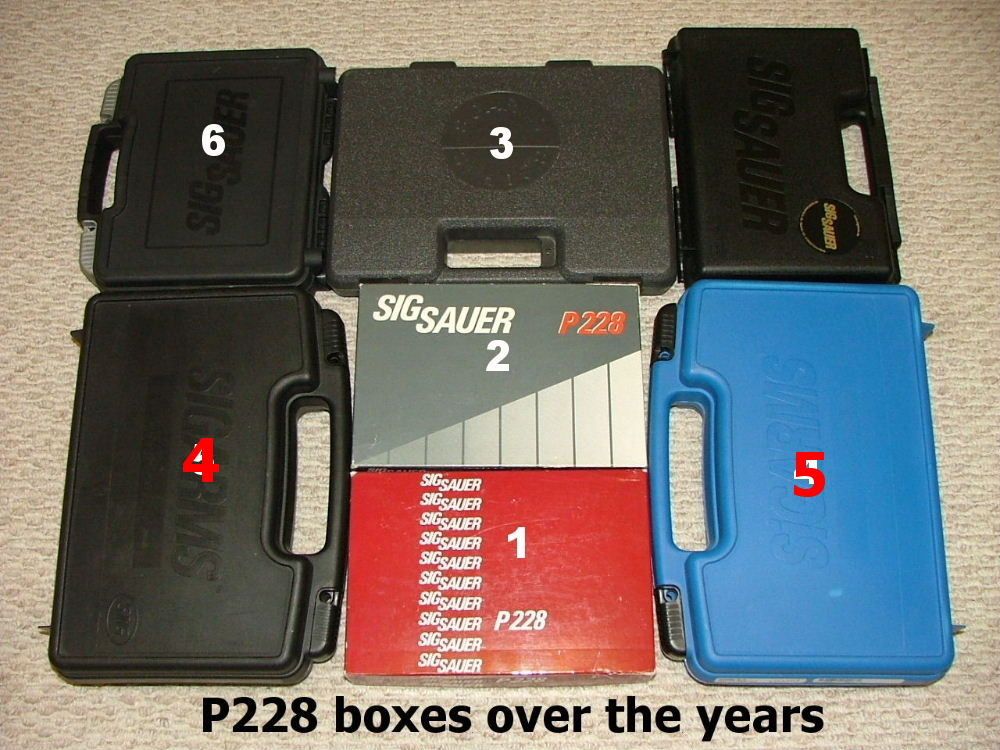
Special note on the gray plastic case (#3): Complete package should include the soft outer cardboard sleeve with the factory labels. If you're missing the sleeve, you can still determine if the plastic case is original to the gun by prying out the right side of the foam insert inside the case. There should be a factory label there with the gun's info (as shown below).
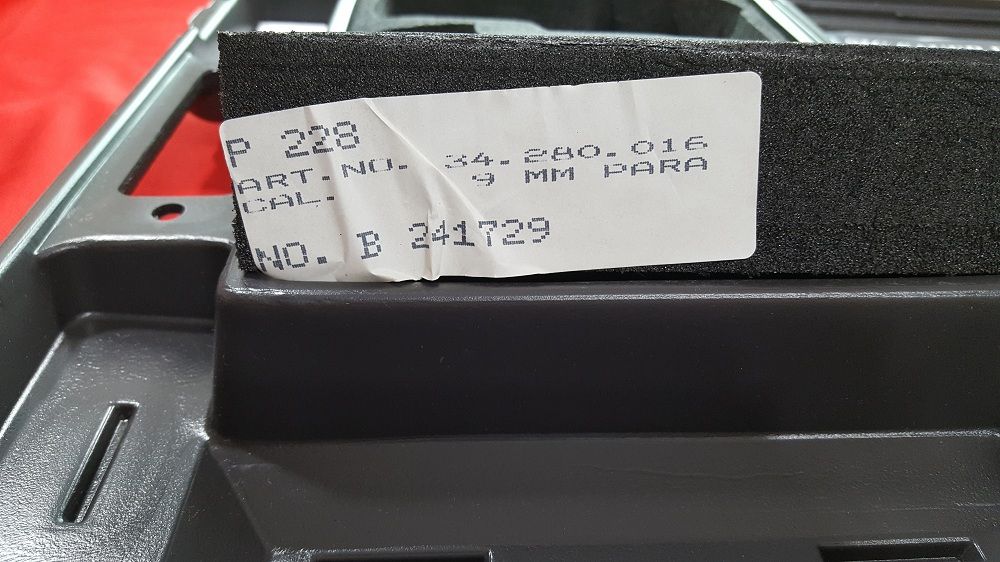
M. Magazines:
i - Early mags (pre-ban) are German made (JK through pre-ban KE):
1. None of them has any "Made In Germany" or "Made in W. Germany" on them.
2. The JK and KA have the following markings on the left side: "SIG SAUER", "P228".
3. The KB through KE have only "SIG SAUER" on the mag's left side, but no "P228".
4. The SIG "triskelion" started its regular appearance on the KB and subsequent years, although it did make spotty appearance on the JK & KA.
5. The date clock on the floor plate did not make its appearance until mid 1994. Just my guess, but that makes sense, as gun makers were staring down the AWB's barrel at the time. Before that, they did not have to worry about it.
6. Zipper back: JK, KA, KB.
7. Dove tails: KC and onward.
ii - Ban era mags have "Made In Germany" rollmarked on right side of body, "SIG SAUER 9mm" on left side of body, have dove tailed back, but no triskelion, since the bottom part was chopped off to make room for the capacity limiting plastic block.
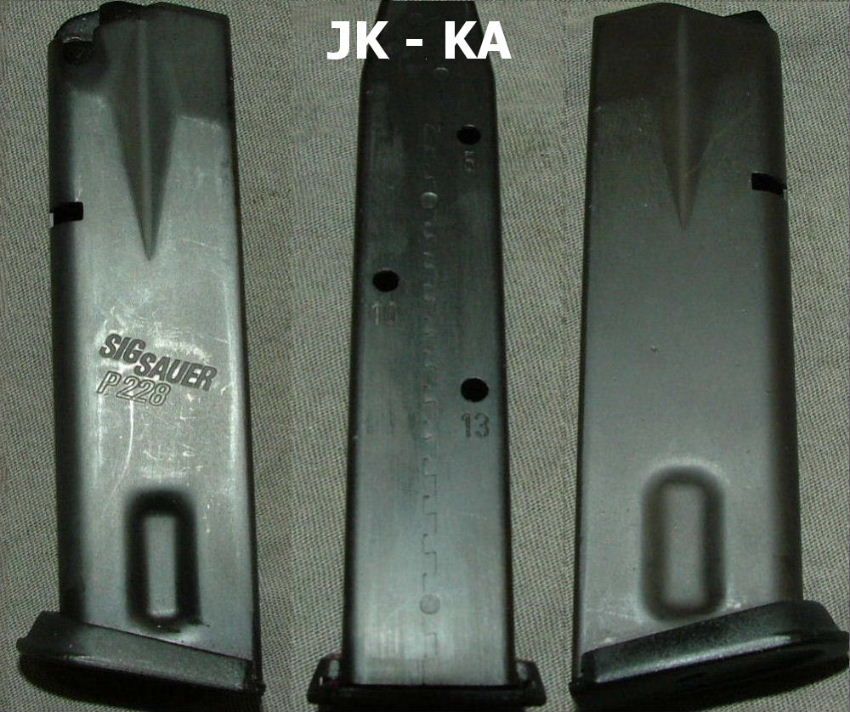
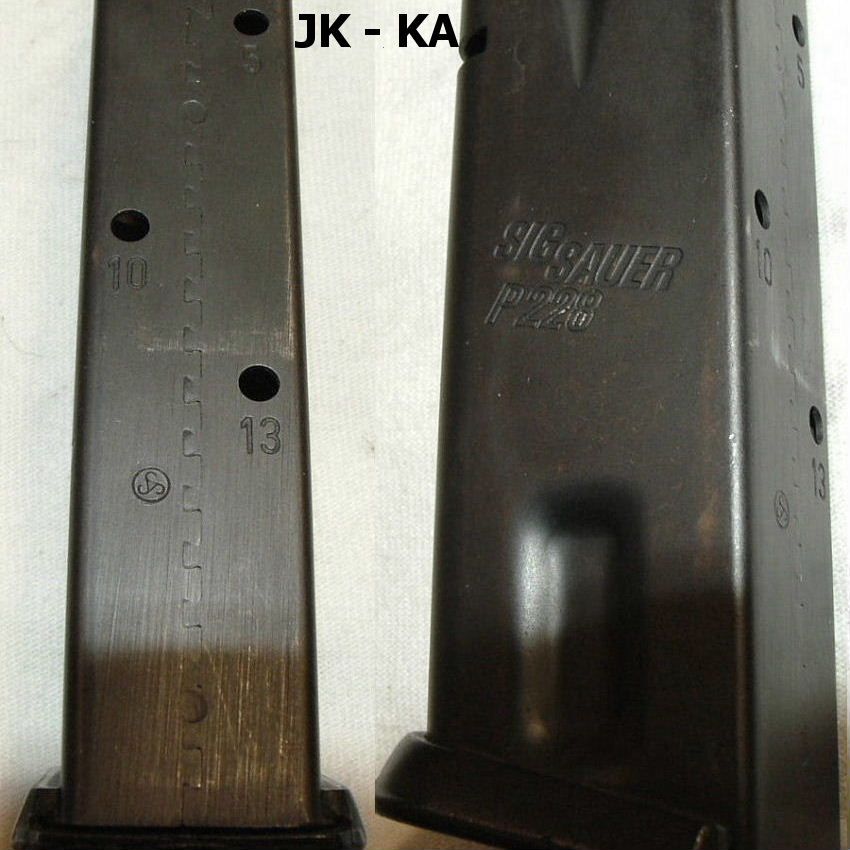
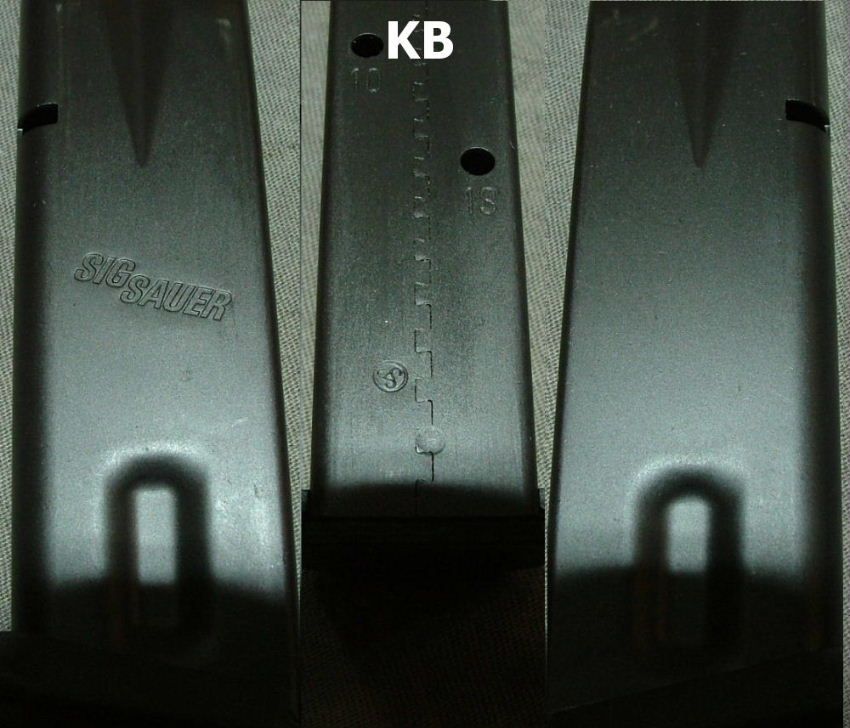
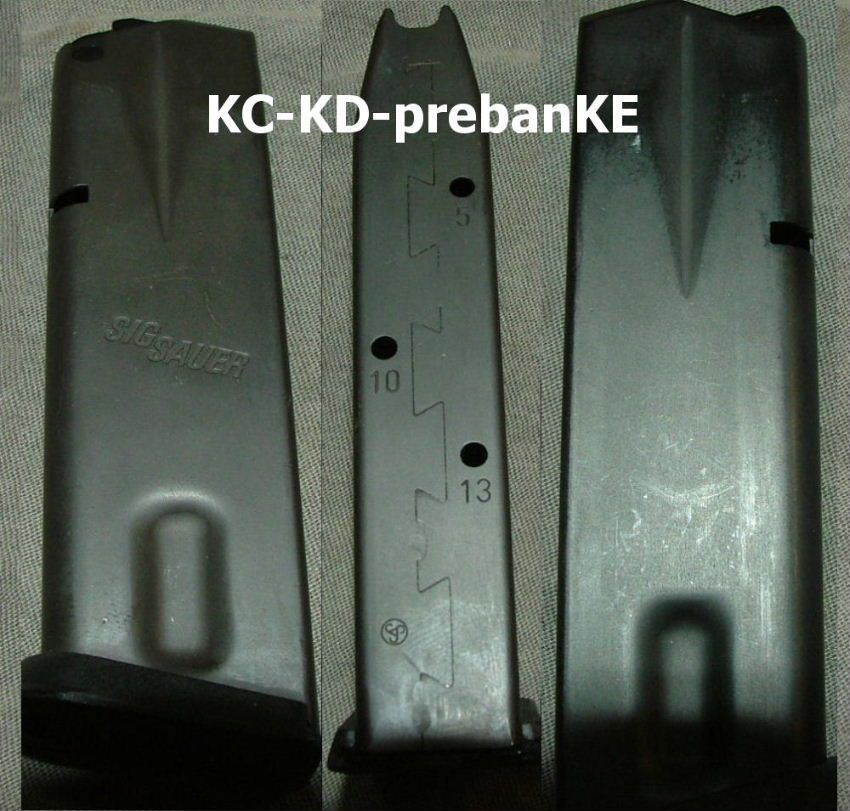
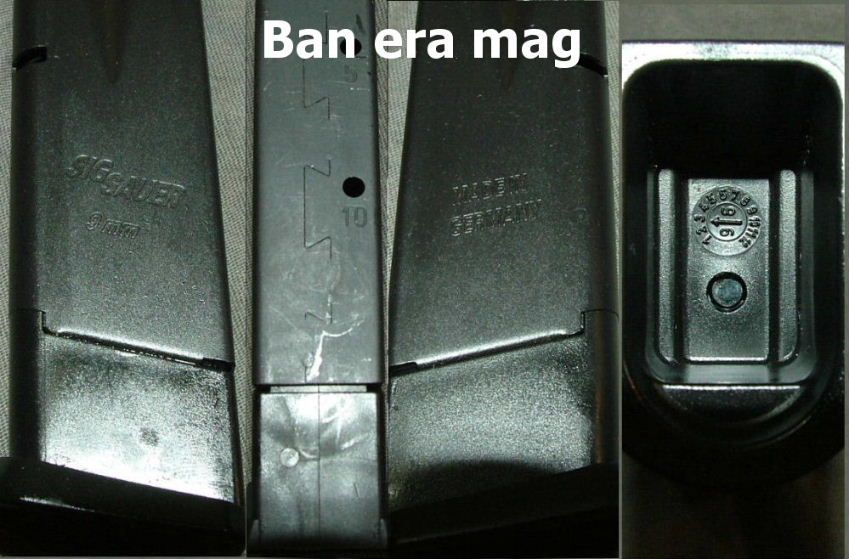
N. Manuals:
In its early years, the P228, like its older brothers (P220, P225, P226), had its own Manual, with red cover. In the subsequent years, the Manual is just generic for all of the "P" models. The 2010 German proofed P228R, however, has the manual specific for it with its own cover page.
